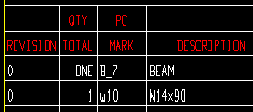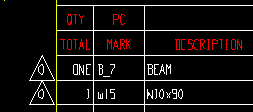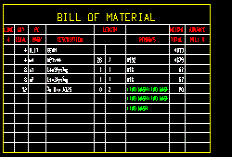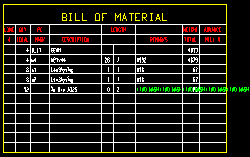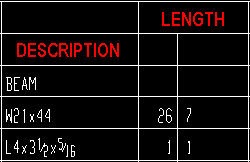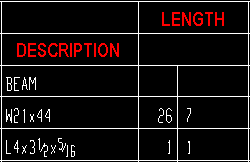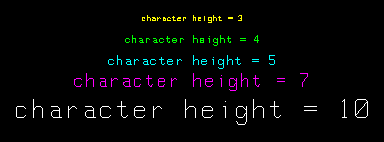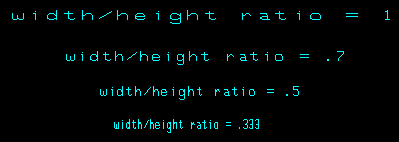Bill of Material Layout review window (opens when you double-click a bill)
| Options on this window are read-only. In a full-featured SDS2 program , users can change the information presented on this window. |
Tabs :
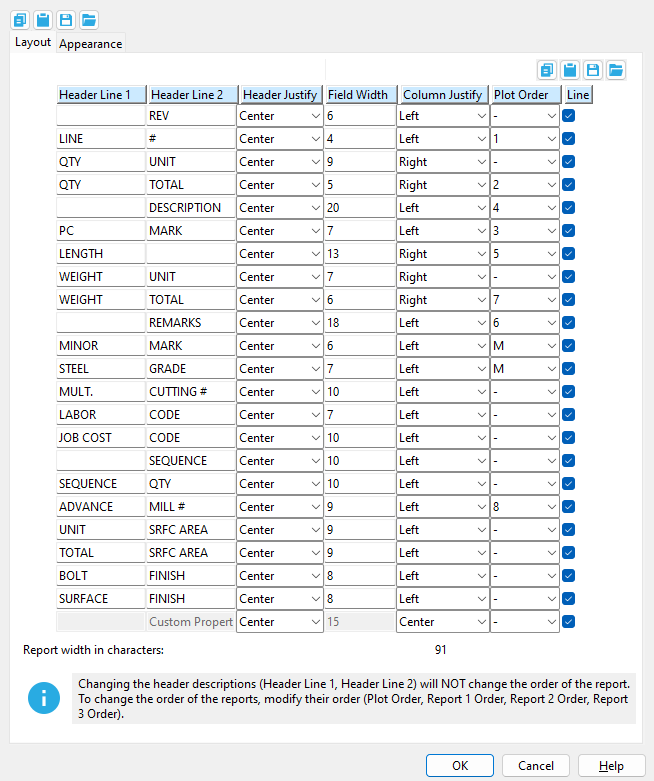
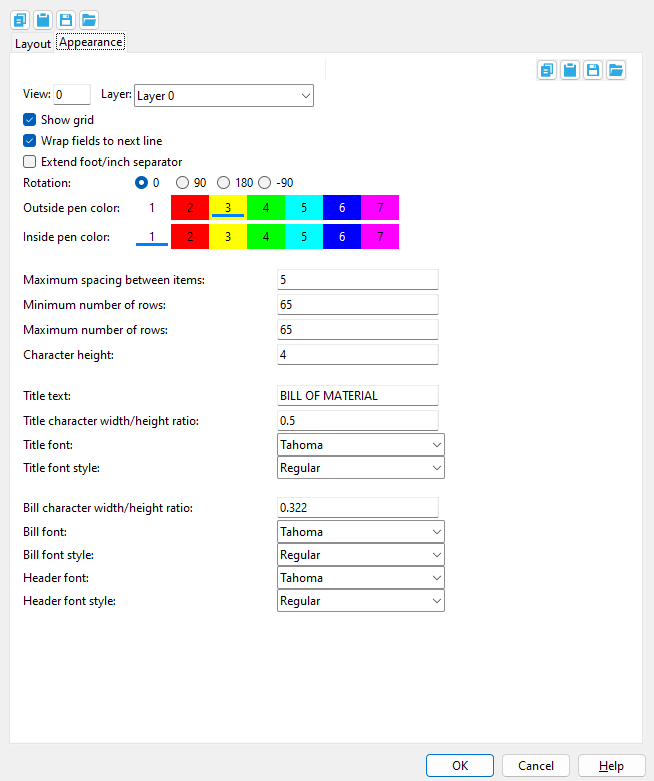
Also see :
- Bill of Material Layout (setup window with options similar to those on this window)
- "Bill of Material" tab in Drawing Presentation (setup options similar to those on this window)
- Bill editor ( Bill of Material Layout affects info shown in)
page 1 | contents | double-click a bill | bill of material | top
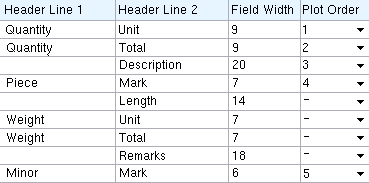
|
| A Bill of Material Layout . Below is a bill of material that has been printed according these settings. |
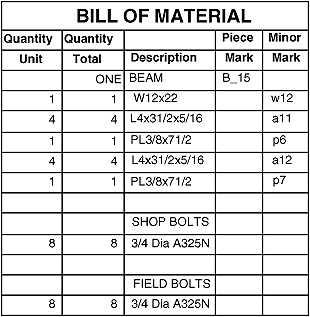
page 1 | contents | double-click a bill | bill of material | top
Header Line 1: The 1st line of the header that appears above a column on the bill or report. The length of this cannot exceed the " Field width ."
Header Line 2 : The 2nd line of the header that appears above a column on the bill or report. The length of this cannot exceed the " Field width ."
Header Justify : The text justification of the Header Line 1 and Header Line 2. The typical practice for this is to ' Center ' them, otherwise they may be ' Left ' or ' Right ' justified.
Field Width : Any integer up to 39. This sets the column width (in characters) on the bill or report.
Column Justify : The text justification of the data inside of the Bill of Material. They may be ' Center ' or ' Left ' or ' Right ' justified.
Plot Order: Inactive or a number (1 through 22) or sometimes Merge. ' Inactive ' stops the column from being printed. A ' number ' sets the order in which the column appears on the bill of material (' 1 ' is the leftmost column, ' 3 ' is third from the left). ' Merge ' routes information to another column on the bill of material.
Line :
or
. This option turns the line on and off between Header Line 1 and Header Line 2. If this box is checked (
) a line is placed between header line. If this is unchecked, the header data is centered where the line would be for a single header. If both header 1 and header 2 have data, the line is just removed and the data stays in the same location.
| Defining the left-to-right order of columns on a bill of material and in the bill editor: |
| Print Order |
| The number that is entered as the " Plot Order " sets the left-to-right order and which columns that are shown on the physical bill and in Edit Bill . |
| Making entries: ' Inactive ' or a ' number ' (' 1 ' through ' 18 ') and sometimes ' Merge ' are allowable entries. ' Inactive ' stops the column from being printed. A ' number ' sets the order in which the column appears on the bill (' 1 ' is the leftmost column, ' 3 ' is third from the left). ' Merge ' routes information to another column on the bill. |
Report width in characters: The total number of characters that the BOM will be wide. This number is automatically calculated from the " Field width " assigned to categories for which a particular order has been assigned. Making a particular category ' Inactive ' decreases the report width. Assigning a " . . . Order " to a category increases the report width.
page 1 | contents | double-click a bill | bill of material | top
| Layout | Appearance |
Revision: If a " Print Order " number is selected, a column for revisions appears on the bill. " Prefix " allows room for placement of a delta symbol with the revision number (or letter) to the left of the revised line in the bill of material.
|
||||
| These examples show only one revision noted in the column or the prefix area. More than one revision may be noted. |
Line #: If a " Print Order " number is selected, a column for revisions appears on the bill. " Prefix " allows room for placement of a delta symbol with the revision number (or letter) to the left of the revised line in the bill of material.
Setup: " Line # "
Unit Quantity: The count of pieces of a particular submaterial that are required to fabricate one of the shipping pieces (members).
| Example: | If you have two identical clip angles (a32) on a beam (B_2), the number 2 will show in the bill of material for the member detail under " Unit Quantity " and in the same row as a32. |
| BOM: | A ' number ' to " Plot Order " sets a " Unit Quantity " column to appear on the physical bills of material you are reviewing. |
| Review Bill: | This does not affect the columns that appear in the bill editor . The columns that appear in the bill editor are controlled by Bill of Material Layout in setup. |
| Note: |
The header " Unit Quantity " may be a different name. However, regardless of its name, the same unit quantity information will still automatically be compiled into it. |
Setup: " Unit Quantity "
Bill Editor: " Unit Quantity "
Total Quantity: The count of submaterials required to fabricate the total number of shipping pieces (members).
| Example: | If you have two identical clip angles (a32) on six identical beams (B_2), the number '12' appears in the " Total Quantity " column on the bill of material in the line for a32. |
| BOM: | A ' number ' to " Plot Order " sets a " Total Quantity " column on the physical bills of material you are reviewing. |
| Review Bill: | This does not affect the columns that appear in the bill editor . The columns that appear in the bill editor are controlled by Bill of Material Layout in setup. |
| Note: | The header " Total Quantity " may be a different name. However, regardless of its name, the same total quantity information will automatically be compiled into it. |
Setup: " Total Quantity "
Bill Editor: " Total Quantity "
Description: A description of the member or material. For a member, the description is the member type. For a submaterial, the description is the section size.
| Example: | The description for the member might read ' BEAM ', while the line beneath BEAM in this same column, corresponding to the member's main material, might read ' W18x40 ', and beneath that might be ' L3x4x5/16 ', corresponding to a submaterial piece with a minor mark. |
| BOM: | A ' number ' to " Plot Order " sets a " Description " column to appear on the physical bills of material you are reviewing. |
| Review Bill: | This does not affect the columns that appear in the bill editor . The columns that appear in the bill editor are controlled by Bill of Material Layout in setup. |
| Reports: | This does not affect the Plot Report . The layout for bill reports is controlled by Bill of Material Layout in setup and cannot be overridden on this window. |
Setup: " Description "
Bill Editor: " Description "
Piece Mark: The member piecemark ( piecemark ) of the shipping piece.
| Please note: Minor marks will also be listed in this column if " Minor Mark " on this same window is set to ' Merge '. |
| BOM: | A ' number ' to " Plot Order " sets a " Piece Mark " column to appear on the physical bill of material you are reviewing. |
| Review Bill: | This does not affect the columns that appear in the bill editor . The columns that appear in the bill editor are controlled by Bill of Material Layout in setup. |
| Reports: | This does not affect the Plot Report . The layout for bill reports is controlled by Bill of Material Layout in setup and cannot be overridden on this window. |
Setup: " Piece Mark "
Bill Editor: " Piece Mark "
Length: The length of the material along its X material axis.
| Please note: This column must be 12 or more characters wide for it to be divided into two (the left side for feet, the right side for inches and fractions of an inch) when imperial " Units " are used. |
| BOM: | A ' number ' to " Plot Order " sets a " Length " column to appear on the physical bill of material you are reviewing. |
| Review Bill: | This does not affect the columns that appear in the bill editor . The columns that appear in the bill editor are controlled by Bill of Material Layout in setup. |
| Reports: | This does not affect the Plot Report . The layout for bill reports is controlled by Bill of Material Layout in setup and cannot be overridden on this window. |
Unit Weight: For a member, this is the total combined weight of the submaterial pieces required to fabricate one shipping member. For a submaterial, this is the weight of one piece of submaterial.
| Example: | If the main material (W18x40) of six identical beams (B_2) has two submaterials (a32 clip angles), the " Unit Weight " of the beam will be the combined weight of ONE W18x40 plus TWO a32's. The " Unit Weight " for the twelve a32's will be the weight of ONE a32. |
| BOM: | A ' number ' to " Plot Order " sets a " Unit Weight " column to appear on the physical bill of material you are reviewing. |
| Review Bill: | This does not affect the columns that appear in the bill editor . The columns that appear in the bill editor are controlled by Bill of Material Layout in setup. |
Setup: " Unit Weight "
Bill Editor: " Unit Weight "
Total Weight: For a member, this is the total combined weight of the submaterials required to fabricate all shipping members that receive the same major mark. For a submaterial, this is the weight of all pieces of that submaterial.
| Example: | If the main material (W18x40) of six identical beams (B_2) has two submaterials (a32 clip angles), then the " Total Weight " of the beam (B_2) will be the combined weight of SIX W18x40's plus TWELVE a32's. The " Total Weight " for the twelve a32's will be twelve times the " Unit Weight " of a single a32. |
| BOM: | A ' number ' to " Plot Order " sets a " Total Weight " column to appear on the physical bill of material you are reviewing. |
| Review Bill: | This does not affect the columns that appear in the bill editor . The columns that appear in the bill editor are controlled by Bill of Material Layout in setup. |
Setup: " Total Weight "
Bill Editor: " Total Weight "
Remarks: User-entered comments and/or information automatically compiled from fields that are set to ' Merge ' .
| Please note: If the " Steel Grade ," " Mult. Cutting # ," " Labor Code ," " Job Cost Code " and " Advance mill # " are set to ' Merge ', they will automatically be entered into the " Remarks " column. Also, definitions from " routing configuration #4 " are compiled into this column. |
| BOM: | A ' number ' to " Plot Order " sets a " Remarks " column to appear on the physical bill of material you are reviewing. |
| Reports: | This does not affect the Plot Report . The layout for bill reports is controlled by Bill of Material Layout in setup and cannot be overridden on this window. |
| Edit Bill: | This does not affect the columns that appear in the bill editor . The columns that appear in the bill editor are controlled by Bill of Material Layout in setup. |
| Warning: | The " Advanced Mill # " cannot be merged into " Remarks " when " Sequence " and " Sequence Quantity " are active. |
User routing definitions (setup): routing configuration #4
Setup: " Remarks "
Bill Editor: " Remarks "
Minor Mark: The submaterial piecemark ( material mark ) of a material.
| BOM: | A ' number ' to " Plot Order " sets a " Minor Mark " column to appear on the physical bill of material you are reviewing. |
| Reports: | This does not affect the Plot Report . The layout for bill reports is controlled by Bill of Material Layout in setup and cannot be overridden on this window. |
| Review Bill: | This does not affect the columns that appear in the bill editor . The columns that appear in the bill editor are controlled by Bill of Material Layout in setup. |
| ' Merge ': | ' Merge ' sets minor piecemarks to be compiled into the " Piece Mark " column, and a " Minor Mark " column does not appear on the physical bill of material. The column does, however, appear in the bill editor so that users can manually edit the minor mark. |
Setup: " Minor Mark "
Bill Editor: " Minor Mark "
Steel Grade: The steel grade of the material.
| BOM: | A ' number ' to " Plot Order " sets a " Steel Grade " column to appear on the physical bill of material that you double-clicked to open this window. |
| Reports: | This does not affect the Plot Report . The layout for bill reports is controlled by Bill of Material Layout in setup and cannot be overridden on this window. |
| Review Bill: | This does not affect the columns that appear in the bill editor . The columns that appear in the bill editor are controlled by Bill of Material Layout in setup. |
| ' Merge ': | ' Merge ' sets steel grade information to compile into the " Remarks " column, and a " Steel Grade " column does not appear on the physical bill of material. The column does, however, appear in the bill editor so that users can manually edit the steel grade. |
Setup: " Steel Grade "
Bill Editor: " Steel Grade "
Mult Cutting #: Any user-entered string .
| Where " Mult Cutting " info comes from : The bill data shown in this column may be a definition from routing configuration #1 that was applied to a member or material, or it may be that a user of a full-featured SDS2 program has manually typed in information to the " Mult. Cutting # " column in the bill editor . |
| BOM: | A ' number ' to " Plot Order " sets a " Mult Cutting # " column on the physical bill of material that you double-clicked to open this window. |
| Reports: | This does not affect the Plot Report . The layout for bill reports is controlled by Bill of Material Layout in setup and cannot be overridden on this window. |
| Review Bill: | This does not affect the columns that appear in the bill editor . The columns that appear in the bill editor are controlled by Bill of Material Layout in setup. |
| ' Merge ': | ' Merge ' sets mult cutting information to compile into the " Remarks " column, and a " Mult Cutting # " column does not appear on the physical bill of material. The column does, however, appear in the bill editor so that users can manually edit the mult cutting number. |
User routing definitions: routing configuration #1
Setup: " Mult Cutting # "
Bill Editor: " Mult Cutting # "
Labor Code: Any user-entered string .
| Where " Labor Code " info comes from: The bill data shown in this column may be a definition from routing configuration #2 that was applied to a member or material. Or it may be that a user of a full-featured SDS2 program has manually typed in information to the " Labor Code " column in the bill editor . |
| BOM: | A ' number ' to " Plot Order " sets a " Labor Code " column to appear in the bill of material. |
| Reports: | This does not affect the Plot Report . The layout for bill reports is controlled by Bill of Material Layout in setup and cannot be overridden on this window. |
| Review Bill: | This does not affect the columns that appear in the bill editor . The columns that appear in the bill editor are controlled by Bill of Material Layout in setup. |
| ' Merge ': | ' Merge ' sets labor code information to compile into the " Remarks " column, and a " Labor Code " column does not appear on the physical bill of material. The column does, however, appear in the bill editor so that users can manually edit the labor code. |
User routing definitions (setup): routing configuration #2
Setup: " Labor Code "
Bill Editor: " Labor Code "
Job Cost Code: Any user-entered string -- for example, to designate the cost (usually per pound or kilogram) of a member or material.
| Where " Job Cost Code " info comes from: The bill data shown in this column may be a definition from routing configuration #3 that was applied to a member or material. Or it may be that a user of a full-featured SDS2 program has manually typed in information to the " Job Cost Code " column in the bill editor . |
| BOM: | A ' number ' to " Plot Order " sets a " Job Cost Code " column on the physical bill of material that you double-clicked to open this window. |
| Reports: | This does not affect the Plot Report . The layout for bill reports is controlled by Bill of Material Layout in setup and cannot be overridden on this window. |
| Review Bill: | This does not affect the columns that appear in the bill editor . The columns that appear in the bill editor are controlled by Bill of Material Layout in setup. |
| ' Merge ': | ' Merge ' sets job cost code information to compile into the " Remarks " column, and a " Job Cost Code " column does not appear on the physical bill of material. The column does, however, appear in the bill editor so that users can manually edit a job cost code. |
User routing definitions (setup): routing configuration #3
Setup: " Job Cost Code "
Bill Editor: " Job Cost Code "
Sequence: The sequence name or sequence number of the member.
| Tip: | It's generally a good idea to set an order here if you have divided the model into sequences and " Break major marks apart " is set to something other than ' Sequence '. |
| BOM: | A ' number ' to " Plot Order " sets a " Sequence " column to appear in the physical bill of material that you double-clicked to open this window. |
| Reports: | This does not affect the Plot Report . The layout for bill reports is controlled by Bill of Material Layout in setup and cannot be overridden on this window. |
| Review Bill: |
This does not affect the columns that appear in the bill editor . The columns that appear in the bill editor are controlled by Bill of Material Layout in setup. |
Sequence Quantity: The quantity (a whole number) of identical members that have the same sequences.
| Example: | Six columns are identical, except that half are assigned a sequence of 1 and half are assigned a sequence of 2. These columns will be listed in two different places on the bill of material, and the sequence quantity for each will be 3. |
| BOM: | A ' number ' to " Plot Order " sets a " Sequence Quantity " column on the physical bill of material that you double-clicked to open this window. |
| Reports: | This does not affect the Plot Report . The layout for bill reports is controlled by Bill of Material Layout in setup and cannot be overridden on this window. |
| Review Bill: | This does not affect the columns that appear in the bill editor . The columns that appear in the bill editor are controlled by Bill of Material Layout in setup. |
Setup: " Sequence Quantity "
Bill Editor: " Sequence Quantity "
Advance Mill #: The page-line (or ABM system ID ) that is assigned to the piece of material listed on this line in the physical bill of material that you are reviewing.
| Please note: The " Advance Mill # " cannot be merged into the " Remarks " column when the " Sequence " and " Sequence Quantity " fields are active. |
| Example: | If the main material of a member is listed on page 100, line 55 of the ABM Report , '100-55' will automatically be compiled into the second line of the member bill of material (member main material is listed on the second line of a member bill). |
| BOM: | A ' number ' to " Plot Order " sets an " Advance Mill # " column on the physical bill of material that you double-clicked to open this window. |
| Reports: | This does not affect the Plot Report . The layout for bill reports is controlled by Bill of Material Layout in setup and cannot be overridden on this window. |
| Review Bill: | This does not affect the columns that appear in the bill editor . The columns that appear in the bill editor are controlled by Bill of Material Layout in setup. |
| ' Merge ': | ' Merge ' sets ABM page-line data to compile into the " Remarks " column, and an " Advance Mill # " column does not appear on the physical bill of material. The column does, however, appear in the bill editor so that users can manually edit the advance mill number. |
Setup: " Advance Mill # "
Bill Editor: " Advance Mill # "
Unit Surface Area: The surface area (" Surface area ") of the material. The reported surface area will be in square feet or square meters (depending on the primary dimension " Units "). SDS2 takes into account cuts made into the material when calculating the area. The total surface area of the member will be reported on line one of the plotted bill.
| BOM: | A ' number ' to " Plot Order " puts a " Unit Surface Area " column on the physical bill of material that you double-clicked to open this window |
| Reports: | This does not affect the Plot Report . The layout for bill reports is controlled by Bill of Material Layout in setup and cannot be overridden on this window. |
| Review Bill: | This does not affect the columns that appear in the bill editor . The columns that appear in the bill editor are controlled by Bill of Material Layout in setup. |
| ' Merge ': | ' Merge ' sets mult cutting information to compile into the " Remarks " column, and the " Unit Surface Area " column does not appear on the physical bill. |
Setup: " Unit Surface Area "
Bill Editor: " Unit Surface Area "
Total Surface Area: For a member (bill line 1), this is the combined surface areas of the submaterials required to fabricate all shipping members that are assigned the same major mark. For a submaterial, this is the combined surface areas of the total quantity of materials referenced in a particular line in the bill of material. The surface area will be expressed in square feet or square meters (depending on the primary dimension " Units ").
| BOM: | A ' number ' to " Plot Order " puts a " Total Surface Area " column on the physical bill of material that you double-clicked to open this window. |
| Reports: | This does not affect the Plot Report . The layout for bill reports is controlled by Bill of Material Layout in setup and cannot be overridden on this window. |
| Review Bill: | This does not affect the columns that appear in the bill editor . The columns that appear in the bill editor are controlled by Bill of Material Layout in setup. |
| ' Merge ': | ' Merge ' sets total surface area information to compile into the " Remarks " column, and the " Total Surface Area " column does not appear on the physical bill. |
Setup: " Total Surface Area "
Bill Editor: " Total Surface Area "
Bolt Finish: The galvanizing finish of the bolt.
| Where " Bolt finish " comes from: When a bolt has a galvanized finish (Mechanically galvanized or Hot dipped galvanized). This is setup in Galvanizing Settings. |
| BOM: | A ' number ' to " Plot Order " sets a " Bolt Finish " column to appear in subsequently Placed bills of material. |
| Reports: | A ' number ' to " Report 1 Order " and/or " Report 2 Order " and/or " Report 3 Order " sets the left-to-right order of the " Bolt Finish " column on the associated report(s). |
| Edit Bill: | A ' number ' to " Plot order " or " Report 1 Order " or " Report 2 Order " or " Report 3 Order " makes a " Bolt Finish " column appear in the bill editor for all details. |
Setup Override: " Galvanizing Settings " and " Bolt Edit "
Surface Finish: The surface finish abbreviation on the material.
|
Where " Surface Finish " info comes from: A finish from the material's Surface Finish inside of the material edit window. In the Surface Finish setup window, add to BOM must be checked for it to show. |
| BOM: | A ' number ' to " Plot Order " sets a " Surface Finish " column on subsequently Placed bills of material. |
| Reports: | A ' number ' to " Report 1 Order " and/or " Report 2 Order " and/or " Report 3 Order " sets the left-to-right order of the " Surface Finish " column on the associated report(s). |
| Edit Bill: | A ' number ' or ' Merge ' to " Plot order " or " Report 1 Order " or " Report 2 Order " or " Report 3 Order " makes a " Surface Finish " column appear in the bill editor for all details. |
| ' Merge ': | ' Merge ' sets surface finish information to compile into the " Remarks " column, and no " Surface Finish " column appears in the physical bill or printed report. The column does, however, appear in the bill editor so that users can manually edit the job cost code. |
Home > Project Settings > Job> Surface Finish
Custom Property: Any member custom property which is set to " ![]() Add to BOM " on the Edit Schema Entry window may be shown here, on this window. The " Add to BOM " option is available in a full-featured SDS2 program , but not in Site Planning.
Add to BOM " on the Edit Schema Entry window may be shown here, on this window. The " Add to BOM " option is available in a full-featured SDS2 program , but not in Site Planning.
| Where XXX is a user-entered column name that identifies the custom property to be compiled to the bill: | |
| BOM: | A ' number ' to " Plot Order " sets a " XXX " column to appear on the physical bill of material that you double-clicked to open this window. |
| Reports: | This does not affect the Plot Report . The layout for bill reports is controlled by Bill of Material Layout in setup and cannot be overridden on this window. |
| Review Bill: | This does not affect the columns that appear in the bill editor . The columns that appear in the bill editor are controlled by Bill of Material Layout in setup. |
| ' Merge ': | ' Merge ' sets custom property information to compile into the " Remarks " column, and the " XXX " column does not appear in the physical bill. |
Setup: " Custom Property "
Bill Editor: " Custom Property "
page 1 | contents | double-click a bill | bill of material | top
| Layout | Appearance |
|
|
|
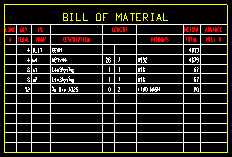
|
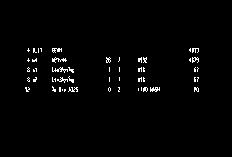
|
If this box is checked (
), the bill of material's interior lines, header text and title text will be shown.
If the box is not checked (
), the bill's interior lines, header text and title text will not be shown.
Setup: " Show grid " under the " Bill of Material " tab in Drawing Presentation .
Wrap fields to next line ![]() or
or ![]() . This applies to the bill of material that you are reviewing when, in a full-featured SDS2 program , more characters have been entered to a cell than that cell has room for.
. This applies to the bill of material that you are reviewing when, in a full-featured SDS2 program , more characters have been entered to a cell than that cell has room for.
|
||||
| In this example, too much text ( shown in green ) was added to the " Remarks " column for a particular piece of material. |
If this box is checked (
), the text will wrap to the next line. If a new line needs to be created, then one will be created so that the text does not overwrite text in other cells.
If the box is not checked (
), the text will spill over to the next cell to the right, overwriting text in that cell. If there is no next cell, the text will spill outside of the bill.
Setup: " Wrap fields to next line " under the " Bill of Material " tab in Drawing Presentation .
Extend foot/inch separator: ![]() or
or ![]() . This applies when a " Length " column is included in the bill of material and the primary dimension " Units " is set to 'I mperial (feet-in frac) '.
. This applies when a " Length " column is included in the bill of material and the primary dimension " Units " is set to 'I mperial (feet-in frac) '.
|
||||
| To see the difference, compare the second row of the " Length " column. |
If this box is checked (
), the line that is the foot/inch separator is extended through the second row of the " Length " column.
If the box is not checked (
), the line that is the foot/inch separator terminates below the second row of the " Length " column.
Rotation : 0º or 90º or 180º or -90º . Rotation is counterclockwise around the insertion point that was used when this bill of material (the one you are reviewing) was created. For a bill of material with 0 degree rotation, that rotation point would be the upper, right corner of the bill.
| 0º | 90º | 180º | -90º |
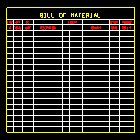
|
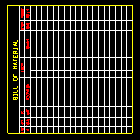
|
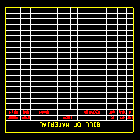
|
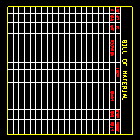
|
Setup: " Rotation " under the " Bill of Material " tab in Drawing Presentation .
Outside pen color: 1 or 2 or 3 or 4 or 5 or 6 or 7 .
|
|
| The selected button sets the pen number and on-screen display color of the bill of material's perimeter. Line Weights sets the thickness of lines drawn with the pen number. |
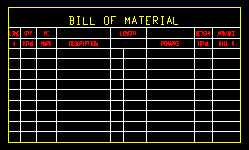
|
The " Outside pen color " sets the color and line thickness of the bill's perimeter. In this example, the color is yellow (pen number 3). |
Setup: " Outside pen color " under the " Bill of Material " tab in Drawing Presentation .
Inside pen color : 1 or 2 or 3 or 4 or 5 or 6 or 7 .
|
|
| The selected button sets the pen number and on-screen display color of the bill of material's interior grid of lines. Line Weights sets the thickness of lines drawn for each of the seven pen numbers. |

|
The " Inside pen color " sets the color and the line thickness for the bill's inner grid. In this example, the color is white (pen 1). |
Setup: " Inside pen color " under the " Bill of Material " tab in Drawing Presentation .
Maximum spacing between items : A number of blank rows . This applies when bill data for more than one member is included in a bill of material that you are reviewing. If there isn't enough room to apply the maximum number of blank rows, the program may reduce the number of blank rows to as few as one row.
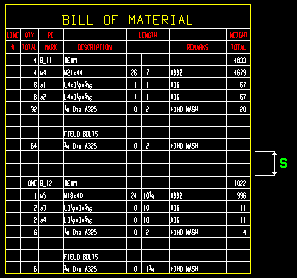
|
s = spacing. In this example, the spacing is two rows. The two rows separate the bill data for member B_11 from the bill data for member B_12. |
Setup: " Maximum spacing between items " under the " Bill of Material " tab in Drawing Presentation .
Minimum number of rows: The number of rows that will be shown in the bill of material you are reviewing when it has no bill data compiled into it. When the user of a full-featured SDS2 program adds bill data to the bill, the number of lines will increase beyond this minimum if and only if doing so is required to accommodate the added data and only if the " Maximum number of rows " is set to a larger number than the minimum.
|
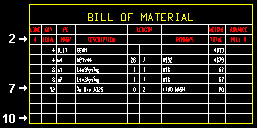
|
In this example, the headers take up 2 rows, the bill data takes up 5 rows, and the " Minimum number of rows " is ' 10 '. This leaves 3 blank rows. |
Setup: " Minimum number of rows " under the " Bill of Material " tab in Drawing Presentation .
Maximum number of rows: The number of rows that the bill of material you are reviewing is allowed to dynamically expand to in order to accommodate new bill data that is added in a full-featured SDS2 program .
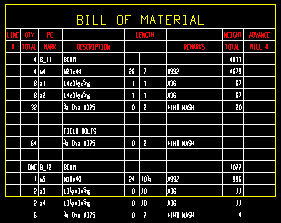
|
In this example, the bill data spills out past the bottom edge of the bill. To fix this problem, just increase the " Maximum number of rows ." |
Setup: " Maximum number of rows " under the " Bill of Material " tab in Drawing Presentation .
Character height: The height ( in millimeters ) of header and bill data text in the bill of material that you are reviewing.
|
Font dependencies: This applies to whatever font is selected as the " Bill font ," regardless of whether that font is a TrueType font or the ' SDS2 ' font.
Setup: The default character height for bill text is the " Bill items character height " in Drawing Presentation .
Bill of material attached to view: A number designating the view that this bill of material is attached to. This applies mainly to member details since it is member details that may have multiple views. If the bill of material you are reviewing is on a sheet outline -- the drawing type a BOM is usually placed on -- you can safely disregard this option.
Layer: The drawing layer (any layer given a " Name ") that the bill of material you are reviewing is placed onto.
![]()
Title text: The characters in the title of the bill of material that you are reviewing. Up to 61 characters may be entered.
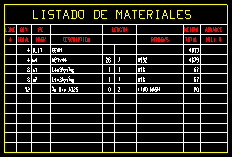
|
The " Title text " in this example is " LISTADO DE MATERIALES ." If a title such as this is on a sheet outline , then all bills of material on sheets that are subsequently created from that sheet outline will have that same title. |
Setup: " Title text "under the " Bill of Material " tab in Drawing Presentation .
Title character width/height ratio: The width/height of the characters that make up the title text in the bill of material that you are reviewing.
|
Font dependencies: This applies to whatever font is selected as the " Title font ," regardless of whether that font is a TrueType font or the ' SDS2 ' font. For a TrueType font, a ratio of ' 0.6 ' renders that font at its native width. A ratio larger than ' 0.6 ' stretches the font. A ratio less than ' 0.6 ' compacts the font. For the ' SDS2 ' font, ' 0.4 ' is the default choice.
Setup: " Title character width/height ratio " under the " Bill of Material " tab in Drawing Presentation .
Title font: Any font that is listed can be selected. The font that is selected applies to the title text, not to the header text or bill data text.

|
The " Title font " applies to the bill title ( BILL OF MATERIAL ). |
Also see: The " Title font style " (below) applies to the " Title font " that is selected here. .
Setup: " Title font " under the " Bill of Material " tab in Drawing Presentation .
Title font style: The style (' Bold ' or ' Bold Italic ' or ' Italic ' or ' Regular ') of the selected " Title font ." Different fonts may have different styles available to them.
Available font styles are listed alphabetically in the font style list box , and the first style that is listed when you change to a different " Title font " is automatically selected as the style for that font. You may, instead of using the automatically selected font style, prefer to choose ' Regular ', which is generally the most popular style for a particular font. ' Regular ' is the only choice that is available for the ' SDS2 ' font.
Setup: " Title font style " under the " Bill of Material " tab in Drawing Presentation .
Bill character width/height ratio: The width/height of the characters that make up header and bill data text in the bill of material that you are reviewing.
|
Font dependencies: This applies to whatever font is selected as the " Bill font ," regardless of whether that font is a TrueType font or the ' SDS2 ' font. For a TrueType font, a ratio of ' 0.6 ' renders that font at its native width. A ratio larger than ' 0.6 ' stretches the font. A ratio less than ' 0.6 ' compacts the font. For the ' SDS2 ' font, ' 0.4 ' is the default choice.
Setup: The default character width/height ratio for bill text is set using " Bill items width/height ratio " in Drawing Presentation . That field applies to title text as well as header text and bill data text. It applies when a new bill of material is added in a full-featured SDS2 program .
Bill font: The font for bill data text.
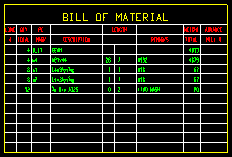
|
The " Bill font " applies to bill data text compiled into the bill ( green in this example ). |
Also see: The " Bill font style " (below) applies to the " Bill font " that is selected here. A bill of material's title text font can be reset in a full-featured SDS2 program by using " Title font "
Setup: " Bill of material font " in Drawing Presentation sets the default font that will be applied to a bill of material when, for example, member details are added to detail sheets in a full-featured SDS2 program .
Bill font style: The style (' Bold ' or ' Bold Italic ' or ' Italic ' or ' Regular ') of the selected " Font ." Different fonts may have different styles available to them.
Available font styles are listed alphabetically in the font style list box , and the first style that is listed when you change to a different " Bill font " is automatically selected as the style for that font. You may, instead of using the automatically selected font style, prefer to choose ' Regular ', which is generally the most popular style for a particular font. ' Regular ' is the only choice that is available for the ' SDS2 ' font.
Setup: " Bill of material font style " in Drawing Presentation sets the default font style that will be applied to a bill of material when it is newly added in a full-featured SDS2 program . That font style will be applied to the bill's title text as well as its header text and data text.
Header font: The font for header text. The " Header font style " that is selected below applies to this font.

|
Headers in this example of a bill of material are displayed in the color red ( LINE # , PC MARK , Description , etc .)i |
Bill of material headers are named by users in a full-featured SDS2 program in Bill of Material Layout ( Fabricator Setup ) by making entries to the " Header line 1 " and " Header line 2 " columns on that setup window or to correspoinding entry fields on this window. The " Header font " is applied to headers when a bill of material is placed in the Drawing Editor . Typically, bills of material are placed on sheet outlines.
Setup: The " Header font " that is entered under the " Bill of Material " tab in Drawing Presentation ( Fabricator Setup ) sets the font that is used, by default, when a bill of material is placed by a user in a full-featured SDS2 program.
Header font style: The style (' Bold ' or ' Bold Italic ' or ' Italic ' or ' Regular ') of the selected " Header font ." Different fonts may have different styles available to them.
Setup: The " Header font style " that is entered under the " Bill of Material " tab in Drawing Presentation ( Fabricator Setup ) sets the font style that is used, by default, when a bill of material is placed by a user in a full-featured SDS2 program.
page 1 | contents | double-click a bill | bill of material | top
